An Update of Transition Metal-Catalyzed Decarboxylative Transformations of Cyclic Carbonates and Carbamates
Abstract
:1. Introduction
2. Transition Metal-Catalyzed Decarboxylation of Cyclic Carbamates
3. Transition Metal-Catalyzed Decarboxylation of Cyclic Carbonates
4. Miscellaneous Substrates
5. Conclusions and Outlook
Author Contributions
Funding
Conflicts of Interest
References
- Weaver, J.D.; Recio III, A.; Grenning, A.J.; Tunge, J.A. Transition Metal-Catalyzed Decarboxylative Allylation and Benzylation Reactions. Chem. Rev. 2011, 111, 1846–1913. [Google Scholar] [CrossRef] [PubMed] [Green Version]
- Rodríguez, N.; Goossen, L.J. Decarboxylative Coupling Reactions: A Modern Strategy for C–C-Bond Formation. Chem. Soc. Rev. 2011, 40, 5030–5048. [Google Scholar] [CrossRef] [PubMed]
- Xuan, J.; Zhang, Z.-G.; Xiao, W.-J. Visible-Light-Induced Decarboxylative Functionalization of Carboxylic Acids and Their Derivatives. Angew. Chem. Int. Ed. 2015, 54, 15632–15641. [Google Scholar] [CrossRef] [PubMed]
- Wei, Y.; Hu, P.; Zhang, M.; Su, W. Metal-Catalyzed Decarboxylative C–H Functionalization. Chem. Rev. 2017, 117, 8864–8907. [Google Scholar] [CrossRef]
- Li, T.-R.; Wang, Y.-N.; Xiao, W.-J.; Lu, L.-Q. Transition-Metal-Catalyzed Cyclization Reactions Using Vinyl and Ethynyl Benzoxazinones as Dipole Precursors. Tetrahedron Lett. 2018, 59, 1521–1530. [Google Scholar] [CrossRef]
- Guo, W.; Gómez, J.E.; Cristòfol, À.; Xie, J.; Kleij, A.W. Catalytic Transformations of Functionalized Cyclic Organic Carbonates. Angew. Chem. Int. Ed. 2018, 57, 13735–13747. [Google Scholar] [CrossRef]
- Allen, B.D.W.; Lakeland, C.P.; Harrity, J.P.A. Utilizing Palladium-Stabilized Zwitterions for the Construction of N-Heterocycles. Chem. Eur. J. 2017, 23, 13830–13857. [Google Scholar] [CrossRef]
- Wang, C.; Tunge, J.A. Asymmetric Cycloadditions of Palladium-Polarized Aza-o-xylylenes. J. Am. Chem. Soc. 2008, 130, 8118–8119. [Google Scholar] [CrossRef]
- Wang, Q.; Li, T.-R.; Lu, L.-Q.; Li, M.-M.; Zhang, K.; Xiao, W.-J. Catalytic Asymmetric [4 + 1] Annulation of Sulfur Ylides with Copper-Allenylidene Intermediates. J. Am. Chem. Soc. 2016, 138, 8360–8363. [Google Scholar] [CrossRef]
- Lu, Y.-N.; Lan, J.-P.; Mao, Y.-J.; Wang, Y.-X.; Mei, G.-J.; Shi, F. Catalytic Asymmetric de novo Construction of Dihydroquinazolinone Scaffolds via Enantioselective Decarboxylative [4 + 2] Cycloadditions. Chem. Commun. 2018, 54, 13527–13530. [Google Scholar] [CrossRef]
- Wang, C.; Li, Y.; Wu, Y.; Wang, Q.; Shi, W.; Yuan, C.; Zhou, L.; Xiao, Y.; Guo, H. Enantioselective Construction of Tetrahydroquinazoline Motifs via Palladium-Catalyzed [4 + 2] Cycloaddition of Vinyl Benzoxazinones with Sulfamate-Derived Cyclic Imines. Org. Lett. 2018, 20, 2880–2883. [Google Scholar] [CrossRef] [PubMed]
- Mun, D.; Kim, E.; Kim, S.-G. Palladium-Catalyzed Decarboxylative [4 + 2] Cycloaddition of Vinyl Benzoxazinanones with Cyclic N-Sulfimines: Stereoselective Synthesis of Benzosulfamidate-Fused Tetrahydroquinazolines. Synthesis 2019, 51, 2359–2370. [Google Scholar] [CrossRef]
- Zhao, H.-W.; Feng, N.-N.; Guo, J.-M.; Du, J.; Ding, W.-Q.; Wang, L.-R.; Song, X.-Q. Diastereoselective and Enantioselective Synthesis of Barbiturate-Fused Spirotetrahydroquinolines via Chiral Palladium (0)/Ligand Complex Catalyzed [4 + 2] Cycloaddition of Vinyl Benzoxazinanones with Barbiturate-Based Olefins. J. Org. Chem. 2018, 83, 9291–9299. [Google Scholar] [CrossRef] [PubMed]
- Wang, Y.-N.; Xiong, Q.; Lu, L.-Q.; Zhang, Q.-L.; Wang, Y.; Lan, Y.; Xiao, W.-J. Inverse-Electron-Demand Palladium-Catalyzed Asymmetric [4 + 2] Cycloadditions Enabled by Chiral P,S-Ligand and Hydrogen Bonding. Angew. Chem. Int. Ed. 2019, 58, 11013–11017. [Google Scholar] [CrossRef] [PubMed]
- Sun, M.; Wan, X.; Zhou, S.-J.; Mei, G.-J.; Shi, F. Iridium and a Brønsted Acid Cooperatively Catalyzed Chemodivergent and Stereoselective Reactions of Vinyl Benzoxazinones with Azlactones. Chem. Commun. 2019, 55, 1283–1286. [Google Scholar] [CrossRef]
- Jiang, X.-L.; Wu, S.-F.; Wang, J.-R.; Lu, H.; Mei, G.-J.; Shi, F. The [4 + 2] Cyclization/Retro-Mannich Reaction Cascade of para-Quinone Methide Derivatives with Pd-Containing 1,4-Dipoles. Org. Biomol. Chem. 2018, 16, 8395–8402. [Google Scholar] [CrossRef]
- Duan, S.; Cheng, B.; Duan, X.; Bao, B.; Li, Y.; Zhai, H. Synthesis of cis-5,5a,6,10b-Tetrahydroindeno [2,1-b]indoles through Palladium-Catalyzed Decarboxylative Coupling of Vinyl Benzoxazinanones with Arynes. Org. Lett. 2018, 20, 1417–1420. [Google Scholar] [CrossRef]
- Punna, N.; Harada, K.; Zhou, J.; Shibata, N. Pd-Catalyzed Decarboxylative Cyclization of Trifluoromethyl Vinyl Benzoxazinanones with Sulfur Ylides: Access to Trifluoromethyl Dihydroquinolines. Org. Lett. 2019, 21, 1515–1520. [Google Scholar] [CrossRef]
- Punna, N.; Das, P.; Gouverneur, V.; Shibata, N. Highly Diastereoselective Synthesis of Trifluoromethyl Indolines by Interceptive Benzylic Decarboxylative Cycloaddition of Nonvinyl, Trifluoromethyl Benzoxazinanones with Sulfur Ylides under Palladium Catalysis. Org. Lett. 2018, 20, 1526–1529. [Google Scholar] [CrossRef]
- Hao, J.; Xu, Y.; Xu, Z.; Zhang, Z.; Yang, W. Pd-Catalyzed Three-Component Domino Reaction of Vinyl Benzoxazinanones for Regioselective and Stereoselective Synthesis of Allylic Sulfone-Containing Amino Acid Derivatives. Org. Lett. 2018, 20, 7888–7892. [Google Scholar] [CrossRef]
- Wang, B.-C.; Wang, Y.-N.; Zhang, M.-M.; Xiao, W.-J.; Lu, L.-Q. Copper-Catalyzed Decarboxylative Cyclization via Tandem C–P and C–N Bond Formation: Access to 2-Phosphorylmethyl Indoles. Chem. Commun. 2018, 54, 3154–3157. [Google Scholar] [CrossRef] [PubMed]
- Li, T.-R.; Zhang, M.-M.; Wang, B.-C.; Lu, L.-Q.; Xiao, W.-J. Synthesis of 3,3′-Biindoles through a Copper-Catalyzed Friedel-Crafts Propargylation/Hydroamination/Aromatization Sequence. Org. Lett. 2018, 20, 3237–3240. [Google Scholar] [CrossRef] [PubMed]
- Zhang, Y.-C.; Zhang, Z.-J.; Fan, L.-F.; Song, J. Enantioselective Decarboxylative Propargylation/Hydroamination Enabled by Organo/Metal Cooperative Catalysis. Org. Lett. 2018, 20, 2792–2795. [Google Scholar] [CrossRef] [PubMed]
- Lu, S.; Ong, J.-Y.; Poh, S.B.; Tsang, T.; Zhao, Y. Transition-Metal-Free Decarboxylative Propargylic Substitution/Cyclization with either Azolium Enolates or Acyl Anions. Angew. Chem. Int. Ed. 2018, 57, 5714–5719. [Google Scholar] [CrossRef]
- Jiang, F.; Feng, X.; Wang, R.; Gao, X.; Jia, H.; Xiao, Y.; Zhang, C.; Guo, H. Asymmetric [3 + 3] Annulation of Copper-Allenylidenes with Pyrazolones: Synthesis of Chiral 1,4-Dihydropyrano[2,3-c]pyrazoles. Org. Lett. 2018, 20, 5278–5281. [Google Scholar] [CrossRef]
- Simlandy, A.K.; Ghosh, B.; Mukherjee, S. Enantioselective [4 + 2]-Annulation of Azlactones with Copper-Allenylidenes under Cooperative Catalysis: Synthesis of α-Quaternary α-Acylaminoamides. Org. Lett. 2019, 21, 3361–3366. [Google Scholar] [CrossRef]
- Ji, D.; Wang, C.; Sun, J. Asymmetric [4 + 2]-Cycloaddition of Copper-Allenylidenes with Hexahydro-1,3,5-triazines: Access to Chiral Tetrahydroquinazolines. Org. Lett. 2018, 20, 3710–3713. [Google Scholar] [CrossRef]
- Wang, Y.; Zhu, L.; Wang, M.; Xiong, J.; Chen, N.; Feng, X.; Xu, Z.; Jiang, X. Catalytic Asymmetric [4 + 3] Annulation of C,N-Cyclic Azomethine Imines with Copper Allenylidenes. Org. Lett. 2018, 20, 6506–6509. [Google Scholar] [CrossRef]
- Chen, H.; Lu, X.; Xia, X.; Zhu, Q.; Song, Y.; Chen, J.; Cao, W.; Wu, X. Asymmetric Catalytic [4 + 2] Cycloaddition via Cu-Allenylidene Intermediate: Stereoselective Synthesis of Tetrahydroquinolines Fused with a γ-Lactone Moiety. Org. Lett. 2018, 20, 1760–1763. [Google Scholar] [CrossRef]
- Liu, K.; Khan, I.; Cheng, J.; Hsueh, Y.J.; Zhang, Y.J. Asymmetric Decarboxylative Cycloaddition of Vinylethylene Carbonates with β-Nitroolefins by Cooperative Catalysis of Palladium Complex and Squaramide. ACS Catal. 2018, 8, 11600–11604. [Google Scholar] [CrossRef]
- Khan, I.; Zhao, C.; Zhang, Y.J. Pd-Catalyzed Asymmetric Decarboxylative Cycloaddition of Vinylethylene Carbonates with 3-Cyanochromones. Chem. Commun. 2018, 54, 4708–4711. [Google Scholar] [CrossRef] [PubMed]
- Gao, X.; Xia, M.; Yuan, C.; Zhou, L.; Sun, W.; Li, C.; Wu, B.; Zhu, D.; Zhang, C.; Zheng, B.; et al. Enantioselective Synthesis of Chiral Medium-Sized Cyclic Compounds via Tandem Cycloaddition/Cope Rearrangement Strategy. ACS Catal. 2019, 9, 1645–1654. [Google Scholar] [CrossRef]
- Yuan, C.; Wu, Y.; Wang, D.; Zhang, Z.; Wang, C.; Zhou, L.; Zhang, C.; Song, B.; Guo, H. Formal [5 + 3] Cycloaddition of Zwitterionic Allylpalladium Intermediates with Azomethine Imines for Construction of N,O-Containing Eight-Membered Heterocycles. Adv. Synth. Catal. 2018, 360, 652–658. [Google Scholar] [CrossRef]
- Zhao, H.-W.; Du, J.; Guo, J.-M.; Feng, N.-N.; Wang, L.-R.; Ding, W.-Q.; Song, X.-Q. Formal [5 + 2] Cycloaddition of Vinylethylene Carbonates to Oxazol-5-(4H)-ones for The Synthesis of 3,4-Dihydrooxepin-2(7H)-ones. Chem. Commun. 2018, 54, 9178–9181. [Google Scholar] [CrossRef]
- Wei, Y.; Liu, S.; Li, M.-M.; Li, Y.; Lan, Y.; Lu, L.-Q.; Xiao, W.-J. Enantioselective Trapping of Pd-Containing 1,5-Dipoles by Photogenerated Ketenes: Access to 7-Membered Lactones Bearing Chiral Quaternary Stereocenters. J. Am. Chem. Soc. 2019, 141, 133–137. [Google Scholar] [CrossRef]
- Yang, Y.; Yang, W. Divergent Synthesis of N-Heterocycles by Pd-Catalyzed Controllable Cyclization of Vinylethylene Carbonates. Chem. Commun. 2018, 54, 12182–12185. [Google Scholar] [CrossRef]
- Das, P.; Gondo, S.; Nagender, P.; Uno, H.; Tokunaga, E.; Shibata, N. Access to Benzo-Fused Nine-Membered Heterocyclic Alkenes with a Trifluoromethyl Carbinol Moiety via a Double Decarboxylative Formal Ring-Expansion Process under Palladium Catalysis. Chem. Sci. 2018, 9, 3276–3281. [Google Scholar] [CrossRef]
- Niu, B.; Wu, X.-Y.; Wei, Y.; Shi, M. Palladium-Catalyzed Diastereoselective Formal [5 + 3] Cycloaddition for the Construction of Spirooxindoles Fused with an Eight-Membered Ring. Org. Lett. 2019, 21, 4859–4863. [Google Scholar] [CrossRef]
- Guo, W.; Kuniyil, R.; Gómez, J.E.; Maseras, F.; Kleij, A.W. A Domino Process toward Functionally Dense Quaternary Carbons through Pd-Catalyzed Decarboxylative C(sp3)−C(sp3) Bond Formation. J. Am. Chem. Soc. 2018, 140, 3981–3987. [Google Scholar] [CrossRef]
- Yang, L.-C.; Tan, Z.Y.; Rong, Z.-Q.; Liu, R.; Wang, Y.-N.; Zhao, Y. Palladium-Titanium Relay Catalysis Enables Switch from Alkoxide-π-Allyl to Dienolate Reactivity for Spiro-Heterocycle Synthesis. Angew. Chem. Int. Ed. 2018, 57, 7860–7864. [Google Scholar] [CrossRef]
- Wang, H.; Qiu, S.; Wang, S.; Zhai, H. Pd-Catalyzed Umpolung of π-Allylpalladium Intermediates: Assembly of All-Carbon α-Vinyl Quaternary Aldehydes through C(sp3)-C(sp3) Coupling. ACS Catal. 2018, 8, 11960–11965. [Google Scholar] [CrossRef]
- Xu, Y.; Chen, L.; Yang, Y.-W.; Zhang, Z.; Yang, W. Vinylethylene Carbonates as α,β-Unsaturated Aldehyde Surrogates for Regioselective [3 + 3] Cycloaddition. Org. Lett. 2019. [Google Scholar] [CrossRef] [PubMed]
- Guo, W.; Martínez-Rodríguez, L.; Kuniyil, R.; Martin, E.; Escudero-Adán, E.C.; Maseras, F.; Kleij, A.W. Stereoselective and Versatile Preparation of Tri- and Tetrasubstituted Allylic Amine Scaffolds under Mild Conditions. J. Am. Chem. Soc. 2016, 138, 11970–11978. [Google Scholar] [CrossRef] [PubMed]
- Deng, L.; Kleij, A.W.; Yang, W. Diversity-Orientated Stereoselective Synthesis through Pd-Catalyzed Switchable Decarboxylative C–N/C–S Bond Formation in Allylic Surrogates. Chem. Eur. J. 2018, 24, 19156–19161. [Google Scholar] [CrossRef]
- Cristòfol, À.; Escudero-Adán, E.C.; Kleij, A.W. Palladium-Catalyzed (Z)-Selective Allylation of Nitroalkanes: Access to Highly Functionalized Homoallylic Scaffolds. J. Org. Chem. 2018, 83, 9978–9990. [Google Scholar] [CrossRef]
- Shi, L.; He, Y.; Gong, J.; Yang, Z. Pd-Catalyzed Decarboxylative Allylation for Stereoselective Syntheses of Allylic Alcohols bearing a Quaternary Carbon Center. Asian J. Org. Chem. 2019, 8, 823–827. [Google Scholar] [CrossRef]
- Ke, M.; Huang, G.; Ding, L.; Fang, J.; Chen, F.-E. Direct Synthesis of Substituted (Z)-Allylic Sulfones by Palladium-Catalyzed Sulfonylation of Vinylethylene Carbonates with Sodium Sulfinates. ChemCatChem 2019. [Google Scholar] [CrossRef]
- Cai, A.; Guo, W.; Martínez-Rodríguez, L.; Kleij, A.W. Palladium-Catalyzed Regio- and Enantioselective Synthesis of Allylic Amines Featuring Tetrasubstituted Tertiary Carbons. J. Am. Chem. Soc. 2016, 138, 14194–14197. [Google Scholar] [CrossRef]
- Khan, A.; Zhang, M.; Khan, S. Regio-and Enantioselective Synthesis of Sulfone-Bearing Quaternary Carbon Stereocenters via Pd-Catalyzed Allylic Substitution. Angew. Chem. Int. Ed. 2019. [Google Scholar] [CrossRef]
- Xia, Y.; Bao, Q.-F.; Li, Y.; Wang, L.-J.; Zhang, B.-S.; Liu, H.-C.; Liang, Y.-M. Ligand-Controlled Regiodivergent π-Allyl Palladium Catalysis Enables a Switch between [3 + 2] and [3 + 3] Cycloadditions. Chem. Commun. 2019, 55, 4675–4678. [Google Scholar] [CrossRef]
- Gómez, J.E.; Cristòfol, À.; Kleij, A.W. Copper-Catalyzed Enantioselective Construction of Tertiary Propargylic Sulfones. Angew. Chem. Int. Ed. 2019, 58, 3903–3907. [Google Scholar] [CrossRef] [PubMed]
- Zhang, Y.-C.; Zhang, B.-W.; Geng, R.-L.; Song, J. Enantioselective [3 + 2] Cycloaddition Reaction of Ethynylethylene Carbonates with Malononitrile Enabled by Organo/Metal Cooperative Catalysis. Org. Lett. 2018, 20, 7907–7911. [Google Scholar] [CrossRef] [PubMed]
- Zhang, Z.-J.; Zhang, L.; Geng, R.-L.; Song, J.; Chen, X.-H.; Gong, L.-Z. N-Heterocyclic Carbene/Copper Cooperative Catalysis for the Asymmetric Synthesis of Spirooxindoles. Angew. Chem. Int. Ed. 2019. [Google Scholar] [CrossRef]
- Hong, S.Y.; Park, Y.; Hwang, Y.; Kim, Y.B.; Baik, M.-H.; Chang, S. Selective Formation of γ-Lactams via C–H Amidation Enabled by Tailored Iridium Catalysts. Science 2018, 359, 1016–1021. [Google Scholar] [CrossRef]
- Park, Y.; Chang, S. Asymmetric Formation of γ-Lactams via C-H Amidation Enabled by Chiral Hydrogen-Bond-Donor Catalysts. Nature Catal. 2019, 2, 219–227. [Google Scholar] [CrossRef]
- Wang, H.; Park, Y.; Bai, Z.; Chang, S.; He, G.; Chen, G. Iridium-Catalyzed Enantioselective C(sp3)-H Amidation Controlled by Attractive Noncovalent Interactions. J. Am. Chem. Soc. 2019, 141, 7194–7201. [Google Scholar] [CrossRef]
- Yu, W.-Y.; Xing, Q.; Chan, C.-M.; Yeung, Y.-W.; Yu, W.-Y. Ruthenium(II)-Catalyzed Enantioselective γ-Lactams Formation by Intramolecular C–H Amidation of 1,4,2-Dioxazol-5-ones. J. Am. Chem. Soc. 2019, 141, 3849–3853. [Google Scholar]
- Tan, T.-D.; Ye, L.-W. Chiral γ-Lactam Synthesis via Asymmetric C–H Amidation. Nature Catal. 2019, 2, 182–183. [Google Scholar] [CrossRef]
- Maity, S.; Potter, T.J.; Ellman, J.A. α-Branched Amines by Catalytic 1,1-Addition of C–H Bonds and Aminating Agents to Terminal Alkenes. Nature Catal. 2019. [Google Scholar] [CrossRef]
- Knecht, T.; Mondal, S.; Ye, J.-H.; Das, M.; Glorius, F. Intermolecular, Branch-Selective, and Redox-Neutral Cp*IrIII-Catalyzed Allylic C–H Amidation. Angew. Chem. Int. Ed. 2019, 58, 7117–7121. [Google Scholar] [CrossRef]
- Burman, J.S.; Harris, R.J.; Farr, C.M.B.; Bacsa, J.; Blakey, S.B. Rh(III) and Ir(III)Cp* Complexes Provide Complementary Regioselectivity Profiles in Intermolecular Allylic C–H Amidation Reactions. ACS Catal. 2019, 9, 5474–5479. [Google Scholar] [CrossRef]
- Lei, H.; Rovis, T. Ir-Catalyzed Intermolecular Branch-Selective Allylic C–H Amidation of Unactivated Terminal Olefins. J. Am. Chem. Soc. 2019, 141, 2268–2273. [Google Scholar] [CrossRef] [PubMed]
- Lee, A.; Zhu, J.L.; Feoktistova, T.; Brueckner, A.C.; Cheong, P.H.-Y.; Scheidt, K.A. Carbene-Catalyzed Enantioselective Decarboxylative Annulations to Access Dihydrobenzoxazinones and Quinolones. Angew. Chem. Int. Ed. 2019, 131, 6002–6006. [Google Scholar] [CrossRef]
- Li, C.; Wang, C.-S.; Li, T.-Z.; Mei, G.-J.; Shi, F. Brønsted Acid-Catalyzed (4 + 3) Cyclization of N,N’-Cyclicazomethine Imines with Isatoic Anhydrides. Org. Lett. 2019, 21, 598–602. [Google Scholar] [CrossRef]


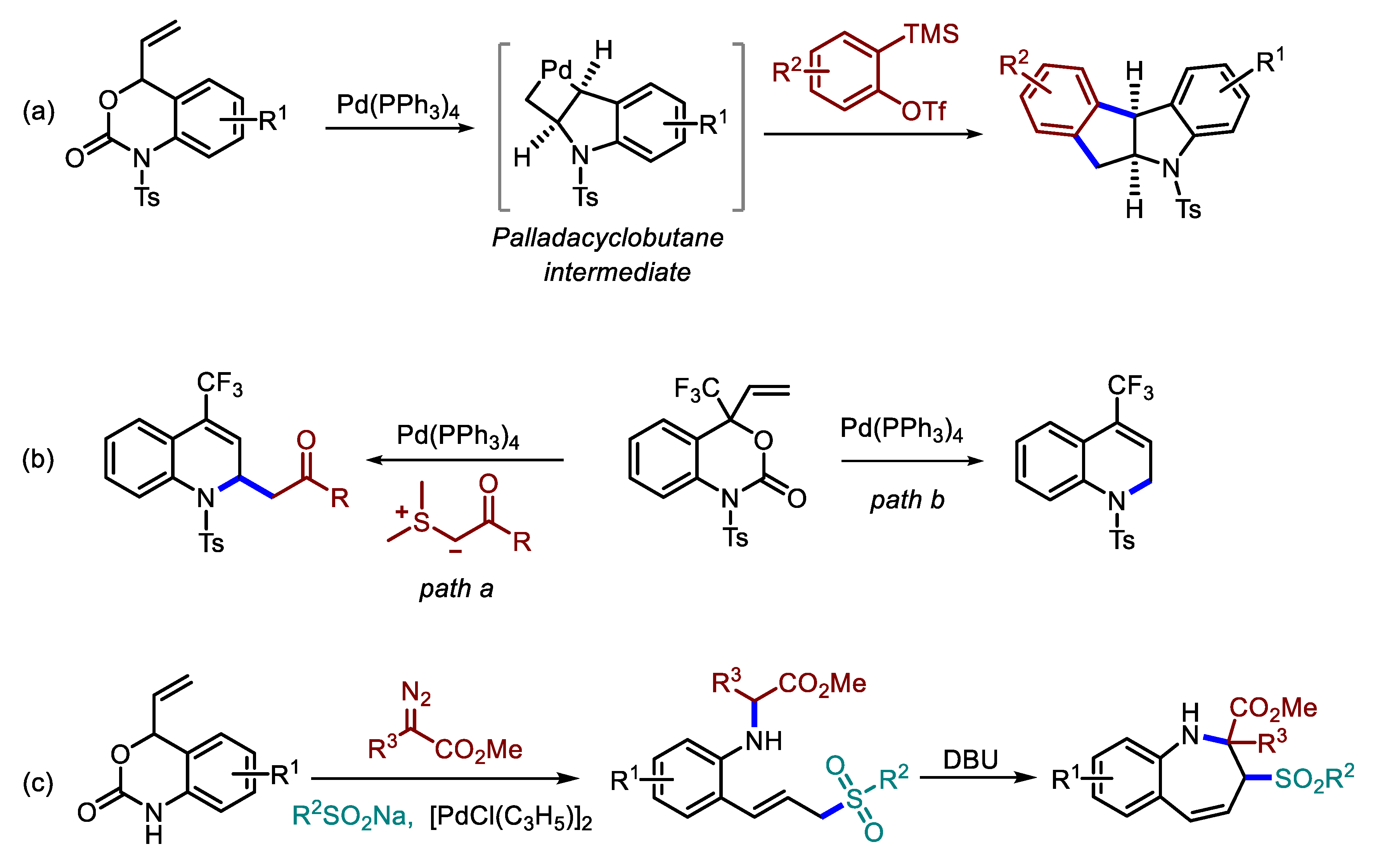
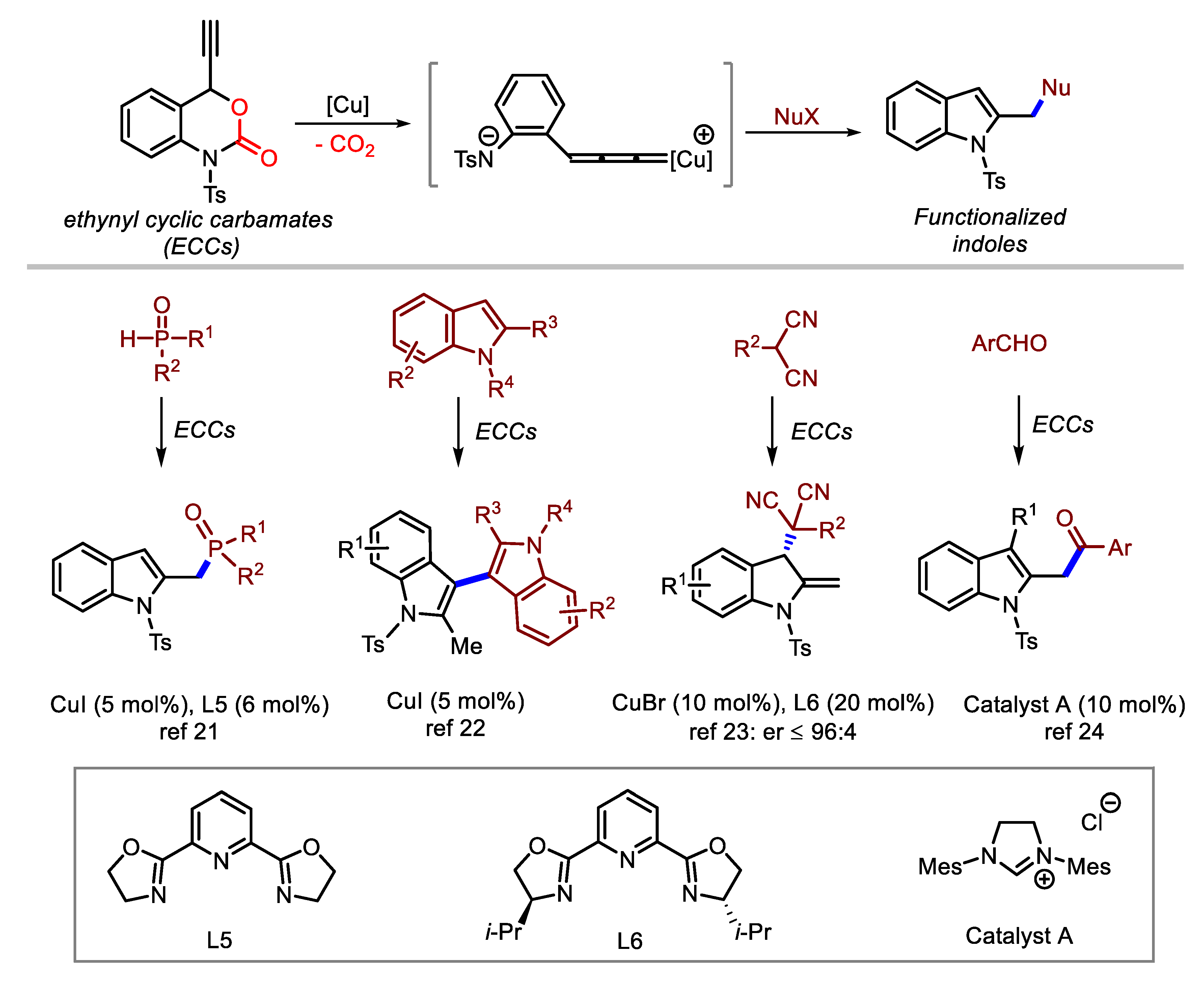
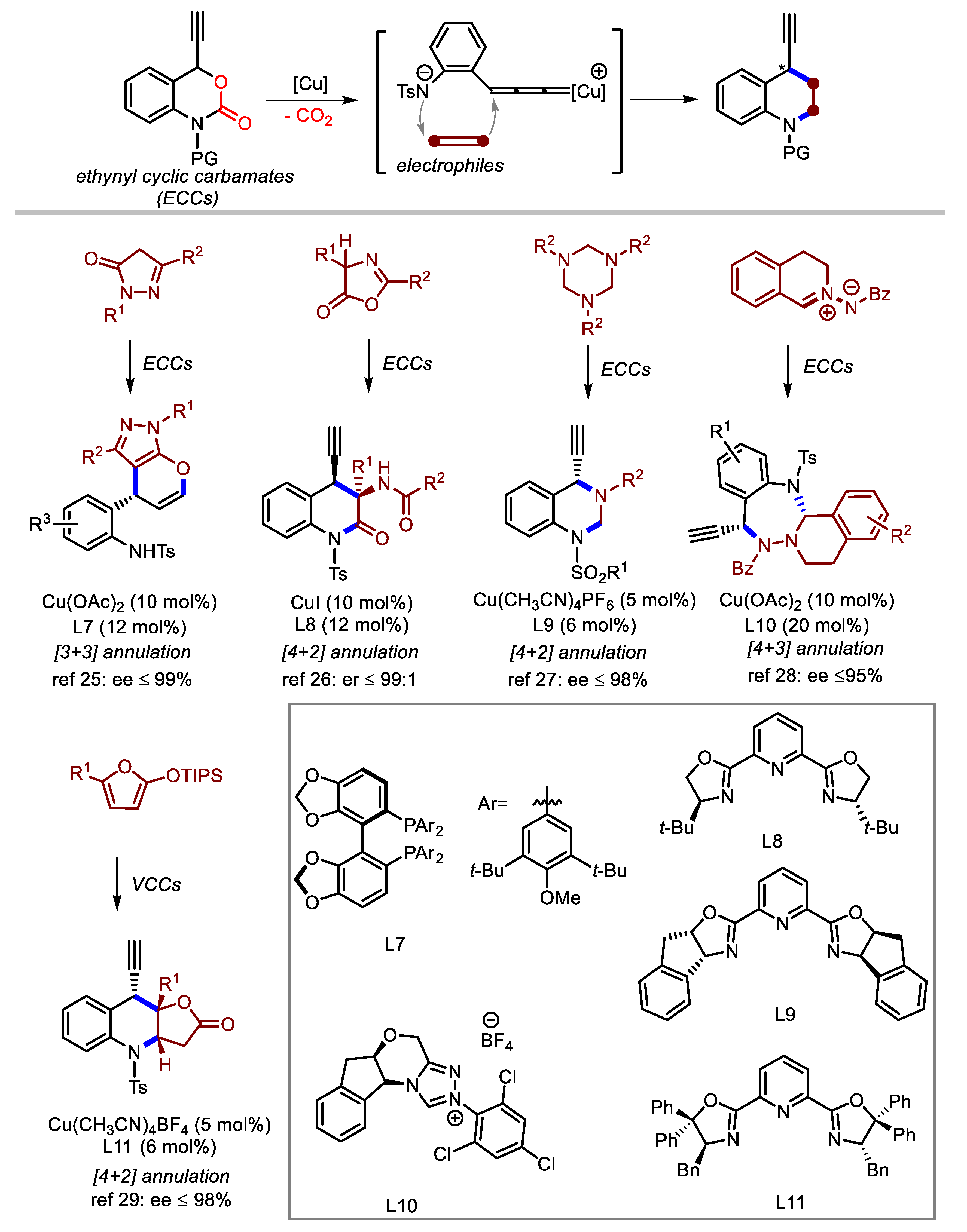


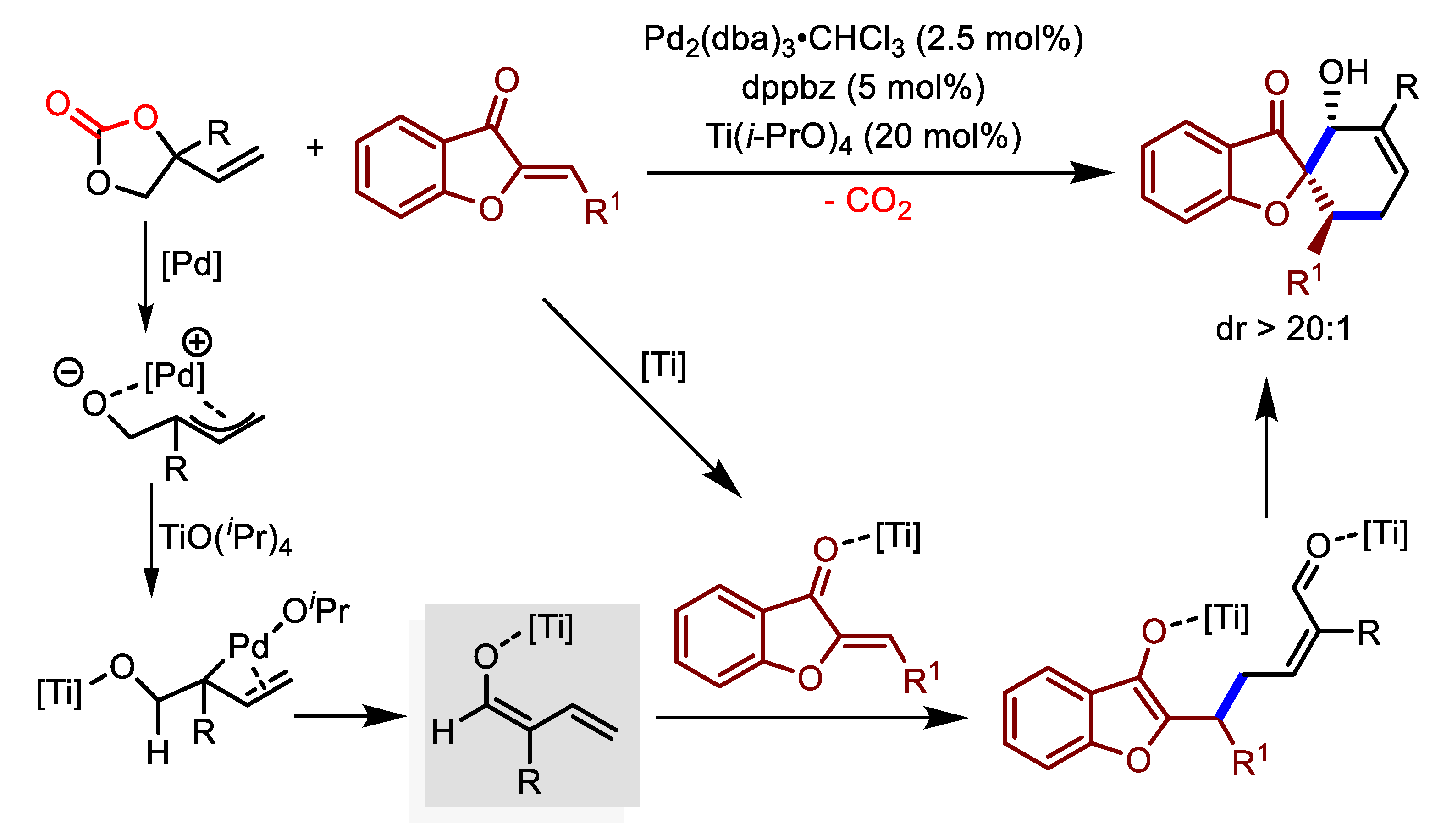

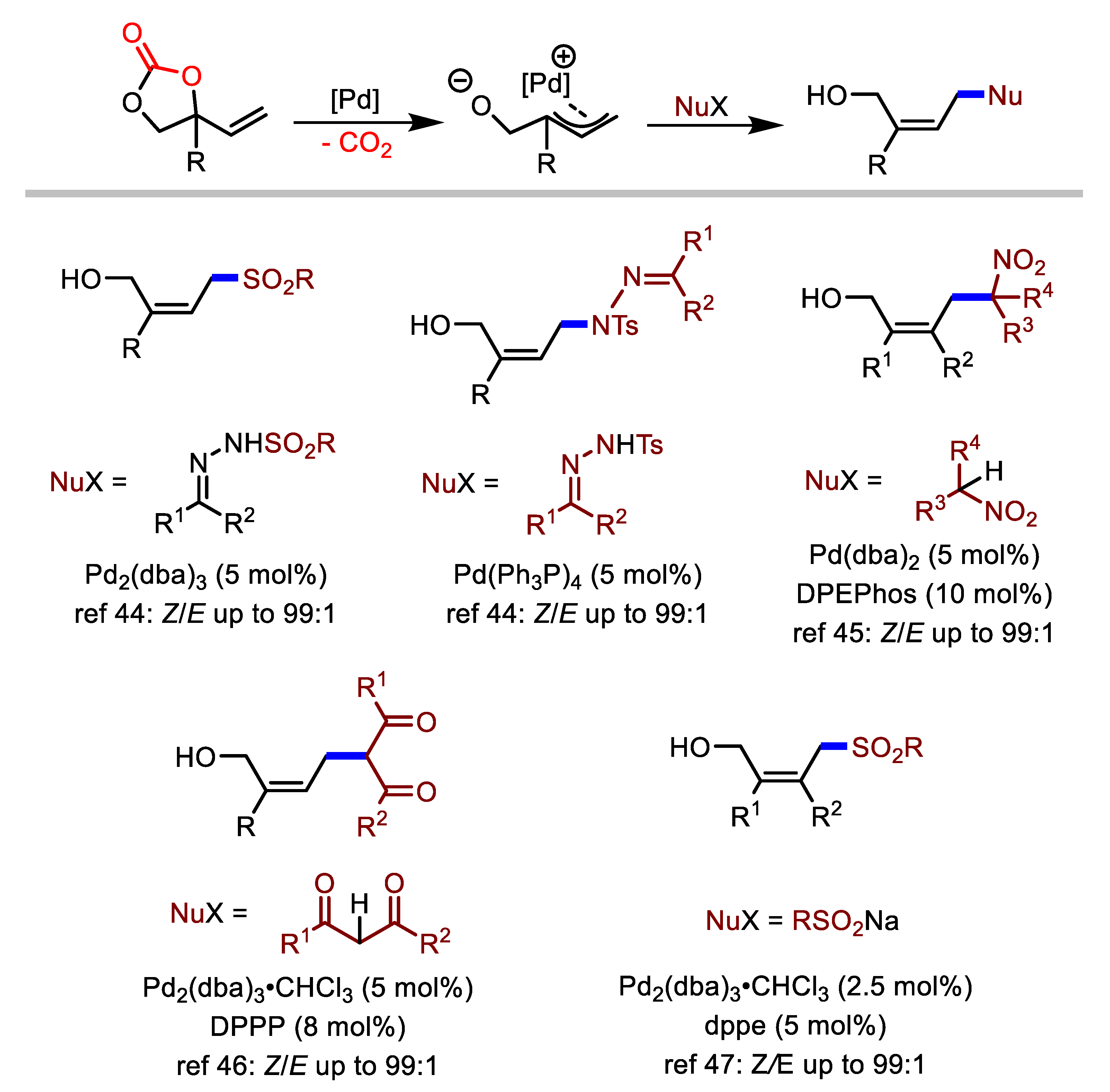


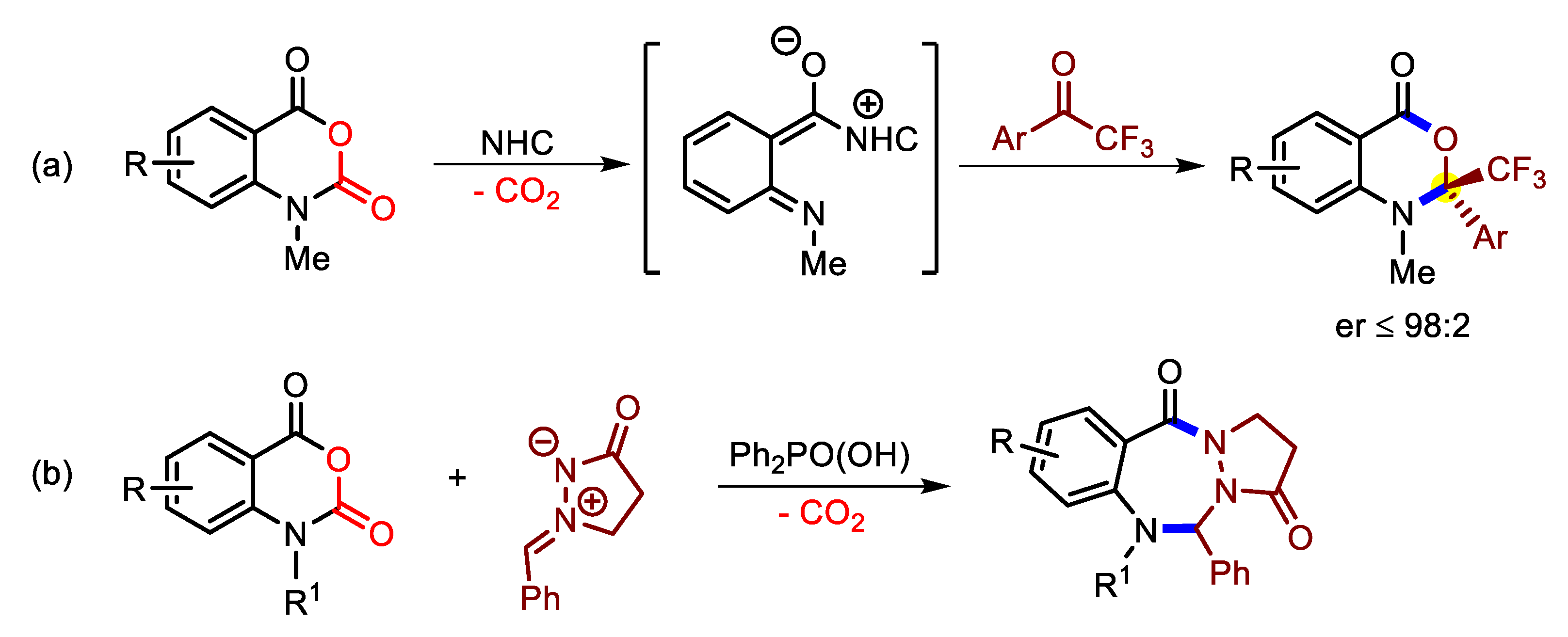
© 2019 by the authors. Licensee MDPI, Basel, Switzerland. This article is an open access article distributed under the terms and conditions of the Creative Commons Attribution (CC BY) license (http://creativecommons.org/licenses/by/4.0/).
Share and Cite
Zuo, L.; Liu, T.; Chang, X.; Guo, W. An Update of Transition Metal-Catalyzed Decarboxylative Transformations of Cyclic Carbonates and Carbamates. Molecules 2019, 24, 3930. https://doi.org/10.3390/molecules24213930
Zuo L, Liu T, Chang X, Guo W. An Update of Transition Metal-Catalyzed Decarboxylative Transformations of Cyclic Carbonates and Carbamates. Molecules. 2019; 24(21):3930. https://doi.org/10.3390/molecules24213930
Chicago/Turabian StyleZuo, Linhong, Teng Liu, Xiaowei Chang, and Wusheng Guo. 2019. "An Update of Transition Metal-Catalyzed Decarboxylative Transformations of Cyclic Carbonates and Carbamates" Molecules 24, no. 21: 3930. https://doi.org/10.3390/molecules24213930





